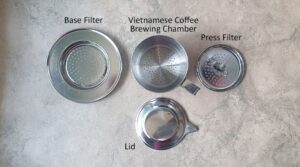Delving into the complexities of coffee can feel overwhelming. Countless factors influence the flavors, aromas, and overall composition of a cup, even before the roasting process begins. Our mission is to empower you with knowledge, making you a more discerning coffee connoisseur and guiding you towards the perfect cup that truly satisfies your palate.
So, where does one begin when selecting a coffee?
For many, the roast color or profile serves as the initial differentiating factor. Generally, any roasters offer three fundamental roast colors:
- Light Roast: This roast allows the inherent flavors of the coffee varieties, terroir, and processing methods to shine through. Light roasts typically exhibit higher perceived acidity and a lighter body compared to darker roasts. Our brewed coffee single origins are all light roasts.
- Medium Roast: Balancing inherent flavors with caramel and chocolate notes imparted by the roast, medium roasts are often considered the sweet spot for espresso. The body is emphasized, and the acidity is mellowed.
- Dark Roast: Dark roasts bring smoky flavors to the forefront, often eclipsing the inherent characteristics of the coffee. The body reigns supreme, and acidity becomes a distant memory.
Once you’ve explored the roast colors, the next step is choosing between seasonal single origin coffees or blends.
Single origin coffees originate from a single farm or cooperative within a specific growing region, expressing the unique terroir—factors like elevation, soil type, and climate—that produce distinct aromas and flavors. Like local strawberries, single origin coffees are best experienced in-season, offering a captivating variety throughout the year. While exceptions exist, here are some general hints for adventurous coffee drinkers:
- Latin America: Guatemala (cocoa, subtle fruit), El Salvador (toasty, cedar), Colombia (caramel, subtle fruit), Brazil (mild, nutty).
- Africa: Kenya (tart, berries), Ethiopia (floral, delicate for washed; berries, wild for natural), Rwanda, and Burundi (spicy, subtle fruit).
- Asia: Vietnam (earthy, full).
Blends, on the other hand, ensure a consistent flavor profile year-round by incorporating different coffees throughout the year. For example, our Vietnamese blends always maintain their classic and caramelized characteristics for strong and bold with very deep flavors and complex flavor notes that can be simultaneously sweet, refreshing, savory, and earthy. Those seeking familiarity often gravitate towards blends, ensuring their coffee tastes the same every morning.
Coffee, at its core, is the seed of a fruit. The method used to remove the seed impacts the final flavor—a process we call the processing method. There are three main categories:
- Washed (Wet): Coffee cherry skins are removed, and the seeds are fermented in the fruit’s mucilage before being washed and dried. Most specialty coffees worldwide undergo the washed process, showcasing the inherent varietal and terroir characteristics.
- Semi-washed (Pulped natural, honey): The mucilage is left on the coffee as it dries, imparting a mellow roundness and potentially some dried fruit characteristics while reducing acidity.
- Natural (Dry): The coffee is dried as a whole cherry with the fruit and skin intact, resulting in wild, berry-like aromas in many cases.
Just like apples or grapes, coffee subspecies are called varieties, each with its own characteristic properties. We will not dive into those varieties as it can get chaotic and if you want to know more about those, a book about coffee is your best bet.
Now, let’s explore the art of tasting coffee.
These basics will help you discern your preferences and appreciate the nuances. Ultimately, it’s up to you to decide whether you enjoy a particular coffee or not.
Before diving in, remember that flavors emerge as coffee cools, so it’s best to give it a few minutes after brewing to fully evaluate it. This not only enhances the tasting experience but also prevents burnt tongues.
- Acidity: This refers to the perceived tartness of a coffee, not its actual pH. Just like an orange without acidity lacks its natural zing, a coffee without acidity falls short. However, too much acidity can make a coffee sour and overpower other characteristics. Words like bright, juicy, and tangy are often used to describe acidity. If this sounds appealing, consider lighter roasts from Kenya, Colombia, and high-altitude Central America.
- Body: Body denotes the perceived weight of the coffee in your mouth—whether it feels full-bodied, thin, or somewhere in between. Grasping body takes time and practice. Think of cream as heavy or full-bodied and non-fat milk as thin or light-bodied. Generally, lighter roast coffees have a thinner body, while darker roast coffees boast a heavier body. Brewing methods also influence perceived body. For example, French press coffee feels heavier, while filtered drip coffee absorbs fewer solids, resulting in a lighter mouthfeel. Explore medium-dark or dark roasts and coffees from Brazil or Asia for a more substantial body.
- Finish: In coffee lingo, finish refers to the aftertaste. How long does the flavor linger on your palate after swallowing (or expectorating) the coffee? A long finish indicates that the flavor lingers, while a short finish means it fades quickly. Some coffees may have flavors that develop and intensify in the finish.
- Aroma: Aroma simply pertains to how brewed coffee smells. It’s a sensory delight, as coffee contains over 800 aromatic compounds. While it’s enjoyable to discover subtle aromatics, don’t worry if you can’t identify every obscure scent. Primary aroma categories include fruity, floral, chocolate, sugar-browning, nutty, earthy, spicy, and herbal.
- Flavor: Flavor encompasses the amalgamation of aromatic and structural elements within your mouth. Sweet, sour, salt, bitter, and body are tastes detected by the tongue. Everything else we perceive in coffee is aromatic or detected by the nose. Broad flavor categories found in coffee include sugar browning (toasty, caramel, etc.), nuts, chocolate, fruit, floral, earthy, herbal, and smoky.
Remember, tasting coffee is a personal journey, and the ultimate goal is to discover what you enjoy most. These guidelines will help you navigate the vast world of coffee flavors and develop a discerning palate.
Lastly, after reading all that, we hope you understand the coffee varieties we are offering and give them a try.






